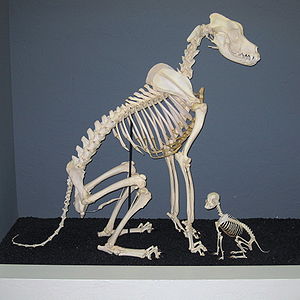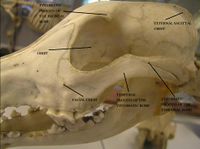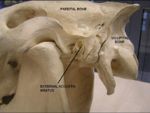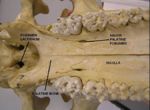Difference between revisions of "Bones - Dog Anatomy"
| Line 55: | Line 55: | ||
==== Ethmoid Bone (''os ethmoidale'') ==== | ==== Ethmoid Bone (''os ethmoidale'') ==== | ||
| − | [[Image:Nasal Cavities.jpg|thumb|right|150px|'''Nasal Cavities''', David Bainbridge]] The ethmoid bone forms part of the cranial and facial parts of the skull and is located deep in the orbit. External lamina consist of the roof plate, floor plate and paired orbital plates. The ethmoid bone is separated from the cranial cavity by the '''cribiform plate'''. Numerous small foramina exist where the '''olfactory nerve''' ([[Cranial Nerves - Anatomy & Physiology|CN I]]) passes through. The perpendicular plate splits the ethmoid into two halves and the ethmoid larbyrinth protrudes from the ethmoid tubes. The tubes are composed of two rows of '''ethmoturbinates''' and air filled '''ethmoidal meatuses'''. Secondary ethmoturbinates may also be present. Ethmoturbinates are divided into '''endoturbinates''' and '''ectoturbinates'''. The first endoturbinate forms the dorsal nasal conchae and the second endoturbinate froms the middle nasal conchae. The endoturbinates form 3 nasal meatuses; the '''dorsal nasal meatus''', the '''middle nasal meatus''' and the '''ventral nasal meatus'''. | + | [[Image:Nasal Cavities.jpg|thumb|right|150px|'''Nasal Cavities''', David Bainbridge]] The ethmoid bone forms part of the cranial and facial parts of the skull and is located deep in the orbit. External lamina consist of the roof plate, floor plate and paired orbital plates. The ethmoid bone is separated from the cranial cavity by the '''cribiform plate'''. Numerous small foramina exist where the '''olfactory nerve''' ([[Cranial Nerves - Anatomy & Physiology|CN I]]) passes through. The perpendicular plate splits the ethmoid into two halves and the ethmoid larbyrinth protrudes from the ethmoid tubes. The tubes are composed of two rows of '''ethmoturbinates''' and air filled '''ethmoidal meatuses'''. Secondary ethmoturbinates may also be present. Ethmoturbinates are divided into '''endoturbinates''' and '''ectoturbinates'''. The first endoturbinate forms the dorsal nasal conchae and the second endoturbinate froms the middle nasal conchae. The endoturbinates form 3 nasal meatuses; the '''dorsal nasal meatus''', the '''middle nasal meatus''' and the '''ventral nasal meatus'''. <br> <br> |
| + | |||
==== Nasal Bone (''os nasale'') ==== | ==== Nasal Bone (''os nasale'') ==== | ||
Revision as of 14:45, 17 November 2012
Introduction
This page is concerned with highlighting the bone anatomy of the domestic dog which will include the major aspects of the anatomy and most of the minor elements of anatomy. Very detailed anatomy of individual bones is not covered below due to space restrictions.
The anatomical information included below is commonly split into three separate areas; head, trunk and the forelimbs / hindlimbs. Therefore the following information will use this concept to facilitate easier understanding of the individual areas of anatomy.
Basic Overview
Head
Anatomically the head encompasses all bones cranial to the cervical vertebrae of the neck and is shown in yellow in the diagram above. The head consists of a number of complex bones of varying types and size which will be both described in text and where possible will also be shown photographically.
Trunk
The trunk is in broad terms the body of the animal and is what would remain if the head and limbs were removed. It can be seperated in four parts, the cervical vertebrae (pink above), thorax (orange above), lumbar region (dark blue above) and pelvis (red, label 6 and torquiose above). Anatomically these structures are highly distinguishable and each area has a distinctive shape, size and physiological role.
Limbs
Head
The head is mainly comprised of the skull, mandible, ossicles and hyoid apparatus. Asscessory cartilage is also present within the external ear, larynx and nose.
Skull

The shape and size of the skull varies widely between different breeds of dog. The skull is divided into three components - the neurocranium, the dermatocranium and the viscerocranium.The skull comprises of many individual bones that are fused together to form a strong single structure. These individual bones in adults are fused via ossification of the cartilage between bones that is found in young animals. The skull protects the brain and head against injury and supports the structures of the face. The neurocranium develops from the neural crest and mesoderm and undergoes endochondral ossification. It lies ventral to the brain. The dermatocranium lies dorsal to the brain and develops from the neural crest and mesoderm. It undergoes intramembranous ossification. The viscerocranium is the pharyngeal skeleton. It is derived only from the neural crest and undergoes endochondral and intramembranous ossification. The various facial muscles attach onto the skull in different places depending on their function. The classification of bones within the skull is based on the traditional views of skull drawings such as the historical drawing shown on the right.
Occipital Bone (os occipitale)
The occipital bone forms the nuchal wall and the foramen magnum. The pars basilaris element is the caudal base of the cranium, although rostral to foramen magnum and joined by a cartilagenous suture to basisphenoid bone. It has muscular tubercules on ventral surface where the flexors of the head and neck attach and a caudocranial fossa encloses the pons and medulla oblongata. The squamous part (pars squamosa) is dorsal to lateral parts and occipital condyles. A nuchal crest is present and is easily palpable. The nuchal crest is often used as a landmark for collection of cerebrospinal fluid (CSF). There are also external occipital protuberances present which provide muscle attachment sites for the nuchal ligament. The lateral parts (partes laterales) form the borders of foramen magnum. Occipital condyles are present which articulate with the atlas to form the atlanto-occipital joint. The paracondylar process provide muscle attachment sites for muscles of the head. The hypoglossal canal is also within this structure.
Sphenoid Bone (os sphenoidale)
The sphenoid bone forms the base of the neurocranium and is composed of a body and wings. The bones are separated by cartilage which ossifies with age. The presphenoid (os praespenoidale) is rostral and has a caudal fossa which is a hollow body with sphenoid sinuses located inside. Within the sinuses are the optic chiasma and optic canal. The basisphenoid (os basispenoidalis) is caudal and has a median cranial fossa. The wings oppose the temporal bone, maxilla, orbit and the brain. The wings also form the oval foramen. The pterygoid processes are also present.
Temporal Bone (os temporale)
The temporal bone is composed of squamous, petrosal and tympanic parts and forms the lateral wall of the cranial cavity. It articulates with the frontal, parietal and sphenoid bones. The squamous element joins the temporal process of the zygomatic bone to form the zygomatic arch and forms the articulating surface of the temporomandibular joint. An articular tubercle and mandibular fossa are present. Occipital process and retrotympanic processes surround the external acoustic meatus whilst the petrosal part encloses the inner ear internally via the internal acoustic meatus. Ventrally this structure forms the mastoid process. The styloid process attaches the hyoid apparatus and a stylomastoid foramen is also present. The tympanic part is the ventral section of the temporal bone containing the tympanic bulla. The tympanic membrane separates tympanic cavity from external acoustic meatus and encloses the auditory ossicle dorsally. The musculotubal canal contains tensors of the soft palate.
Frontal Bone (os frontale)
The frontal bone is a paired structure joined by the interfrontal suture between the cranium and the face and enclosing the frontal sinuses. The nasal and lacrimal bones border the frontal squama section and form the zygomatic process laterally and part of the orbit dorsally. Lacrimal glands are also present near the orbit. The temporal line extends into the external sagittal crest. Ruminants also have a cornual process in horned variants. The nasal section is the rostral part of the frontal bone and the orbital part is perforated by the ethmoidal foramen. Medially the dorsal oblique muscle of the eyeball attaches. The temporal part provides the muscle attachments for the temporalis muscle.
Parietal Bone (os parietale)
The parietal bone is a paired structure and forms the dorsolateral wall of the cranium with the cccipital bone caudally and the frontal bone rostrally. It is composed of a parietal plane, temporal plane and a nuchal plane (in the ox). Internally the grooves and ridges correspond with the gyri and sulci of the brain. There is also an interparietal bone between the occipital bone and the parietal bone which fuses with age.
>
Ethmoid Bone (os ethmoidale)
The ethmoid bone forms part of the cranial and facial parts of the skull and is located deep in the orbit. External lamina consist of the roof plate, floor plate and paired orbital plates. The ethmoid bone is separated from the cranial cavity by the cribiform plate. Numerous small foramina exist where the olfactory nerve (CN I) passes through. The perpendicular plate splits the ethmoid into two halves and the ethmoid larbyrinth protrudes from the ethmoid tubes. The tubes are composed of two rows of ethmoturbinates and air filled ethmoidal meatuses. Secondary ethmoturbinates may also be present. Ethmoturbinates are divided into endoturbinates and ectoturbinates. The first endoturbinate forms the dorsal nasal conchae and the second endoturbinate froms the middle nasal conchae. The endoturbinates form 3 nasal meatuses; the dorsal nasal meatus, the middle nasal meatus and the ventral nasal meatus.
Nasal Bone (os nasale)
The nasal bone is a paired structure and forms the roof of the nasal cavity. Dorsal nasal conchae attach to the ethmoidal crest on the internal surface. A rostral suture forms the apex and between the nasal and incisive bones is the nasoincisive notch.
Lacrimal Bone (os lacrimale)
The lacrimal bone forms part of the lateral wall of the face and orbit and is situated near the medial canthus. It articulates with the frontal bone, zygomatic bone and maxilla. It also articulates with the nasal bone in ruminants and the horse and articulates with the palatine bone in carnivores. It is composed of an orbital and facial part separated by supra- and infraorbital margins. The nasolacrimal duct is present by the margin of the orbital surface. The ventral oblique muscle attaches caudal to the margin of the orbital surface. The nasal surface forms the boundaries of the maxillary and frontal sinuses.
Zygomatic Bone (os zygomaticum)
The zygomatic bone is lateral and ventral to the lacrimal bone and forms the orbit and zygomatic arch. The supraorbital margin is formed by the zygomatic process of the temporal bone and the frontal process of the zygomatic bone. The facial crest is present on lateral surface.
Incisive Bone (os incisivium)
The incisive bone is a paired structure composed of body, nasal, palatine and alveolar parts. It joins with the maxilla to form the interalveolar margin. It also forms the rostral part of the facial section of the skull, the roof of the hard palate and the opening to the nasal cavity. The alveolar process forms conical sockets for the incisor teeth.
Palatine Bone (os palatinum)
The palatine bone is a paired structure between the maxilla, sphenoid and pterygoid bones. It is composed of a horizontal plate (forms part of the hard palate), perpendicular plate (forms the dorsal and lateral walls of the nasopharyngeal meatus) and the choanae. The nasal crest present on the horizontal plate. The palatine sinus is present on horizontal plate.
Vomer
The vomer is unpaired and extends from the choanae of the palatine bone to the floor of the nasal cavity. It attaches to the median nuchal crest and has a septal sulcus which surrounds nasal cavity.
Pterygoid Bone (os pterygoideum)
The pterygoid bone is a paired structure bordered by the palatine and sphenoid bones. It forms the dorsal and lateral walls of the nasopharyngeal cavity. The pterygoid hamulus is formed by the pterygoid bone.
Maxilla
The maxilla forms most of the facial part of the skull, including the lateral walls of the face, nasal cavity, oral cavity and hard palate. It also forms the ventral nasal conchae and articulates with all of the facial bones as it is the largest bone of the face. The maxillary body encloses the maxillary sinuses and forms the external surface of the face. It also forms the facial crest. The infraorbital foramen is palpable. The conchal crest is on nasal surface where the ventral nasal conchae attaches. The lacrimal canal opens into the lacrimal foramen on the nasal surface. The pterygopalatine surfaces are the caudal part of the maxilla which terminate in the maxillary tubercle where the sphenopalatine, maxillary and caudal palatine foramen are present. The alveolar processes present are separated by interalveolar septa. The palatine process forms the hard palate with the palatine bone. The palatine fissure is formed at the articulation with the incisive bone. The nasal surface of palatine process forms the nasal crest and encloses part of the palatine sinuses. The oral surface has numerous palatine foramina present.
Mandible (mandibula)
The mandible can be divided into the body and the ramus. The body of the mandible supports the incisor teeth (rostrally) and cheek teeth (caudally). The section of the body which does not support any teeth is called the interalveolar margin or diastema. The mandibule also contains the mandibular canal and the mental foramen. The facial notch is on the ventral surface where the parotid duct (in herbivores) and facial vessels run. The ramus extends from the caudal end of the body dorsally towards the zygomatic arch. The masseter muscle attaches to the lateral surface at the masseteric fossa. The medial pterygoid attaches to the medial surface at the pterygoid fossa. The angle of the mandible terminates dorsally in the condylar process and the coronoid process which are separated by the mandibular notch. The temporal muscle inserts onto the coronoid head. The condylar process articulates with the mandibular process of the skull (see here).
Trunk
Forelimb






